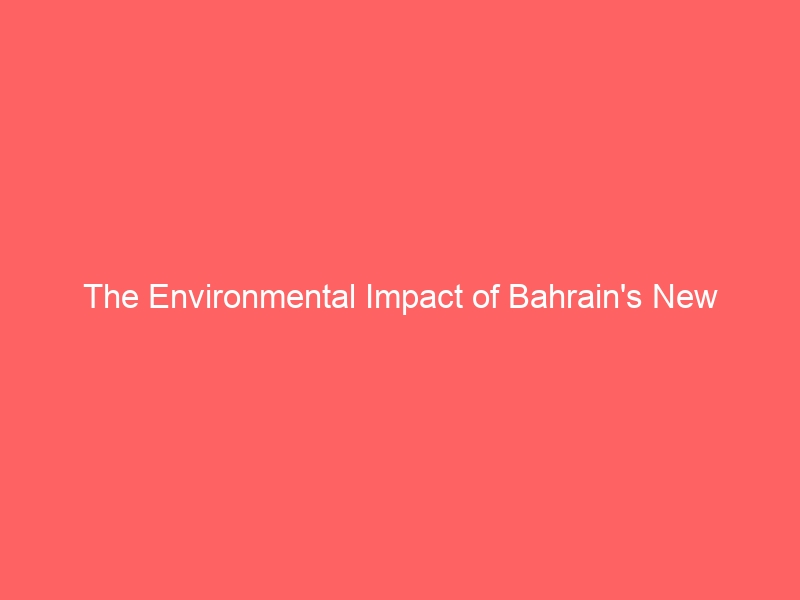Bahrain is a small island nation located in the Arabian Gulf, known for its rich history and booming economy. However, as with many countries around the world, Bahrain is also facing the challenge of managing its waste in a sustainable and environmentally friendly manner. In an effort to address this issue, the Bahraini government has recently announced the construction of a new waste incinerator. While this development is being hailed as a positive step towards modernizing the country’s waste management infrastructure, it has also raised concerns about its potential impact on the environment.
The Environmental Impact of Bahrain’s New Incinerator
The construction of the new waste incinerator in Bahrain is expected to have a significant impact on the environment in several ways. One of the key concerns is the release of air pollutants and greenhouse gases from the incineration process. Incinerators are known to emit a variety of toxic substances, including dioxins, furans, and heavy metals, which can have harmful effects on human health and the environment.
In addition, the ash produced by the incineration of waste can also pose a threat to the environment. If not properly handled and disposed of, the ash can contaminate soil and water, leading to long-term environmental damage. Furthermore, the incineration of organic waste can also contribute to the emission of greenhouse gases, such as carbon dioxide and methane, which are major contributors to climate change.
Another environmental concern is the potential impact of the incinerator on local wildlife and ecosystems. The construction and operation of the incinerator could disrupt natural habitats and wildlife in the surrounding areas, leading to negative ecological consequences. Additionally, the release of air pollutants from the incinerator could have a detrimental impact on the health of plant and animal species in the vicinity.
Furthermore, the incinerator is likely to result in increased traffic and noise pollution in the area, which could have adverse effects on the quality of life for local residents. The transportation of waste to the incinerator, as well as the operation of the facility itself, are expected to generate additional noise and air pollution, creating a potential nuisance for nearby communities.
However, it is important to note that the environmental impact of the new incinerator will largely depend on the measures taken to mitigate its effects. With proper planning and implementation of environmental safeguards, it is possible to minimize the negative impact of the incinerator on the environment.
FAQs
Q: What are the potential health risks associated with the new incinerator?
A: The incineration of waste can release a variety of harmful substances, such as dioxins, furans, and heavy metals, which can pose a risk to human health. These pollutants can cause respiratory problems, cardiovascular diseases, and even cancer if exposure levels are high enough.
Q: Will the incinerator contribute to climate change?
A: Yes, the incineration of waste releases greenhouse gases such as carbon dioxide and methane, which are major contributors to climate change. This can exacerbate global warming and contribute to environmental degradation.
Q: How will the new incinerator affect local wildlife and ecosystems?
A: The construction and operation of the incinerator could disrupt natural habitats and wildlife in the surrounding areas, leading to negative ecological consequences. Additionally, the release of air pollutants from the incinerator could have a detrimental impact on the health of plant and animal species in the vicinity.
Q: Can the environmental impact of the incinerator be mitigated?
A: Yes, with proper planning and implementation of environmental safeguards, it is possible to minimize the negative impact of the incinerator on the environment. This could include the use of advanced pollution control technologies, proper handling and disposal of ash, and the establishment of buffer zones to protect local wildlife and ecosystems.
In conclusion, while the construction of a new waste incinerator in Bahrain is expected to modernize the country’s waste management infrastructure, it also raises concerns about its potential impact on the environment. The release of air pollutants, greenhouse gases, and the potential disruption of local wildlife and ecosystems are all valid concerns that must be addressed in the planning and implementation of the incinerator. It is crucial that the Bahraini government takes proactive measures to minimize the environmental impact of the incinerator and ensure that it operates in a sustainable and responsible manner. Only through careful planning and rigorous environmental safeguards can the harmful effects of the incinerator be mitigated, and the environmental well-being of Bahrain be preserved for future generations.
The Environmental Impact of Bahrain’s New Incinerator




